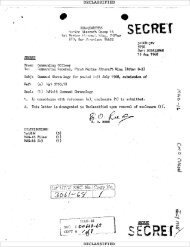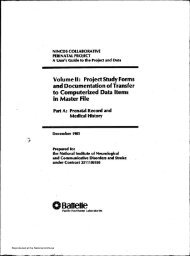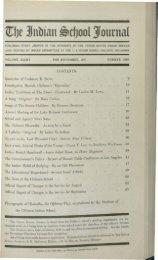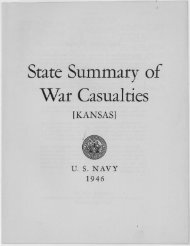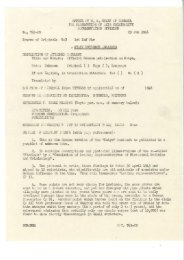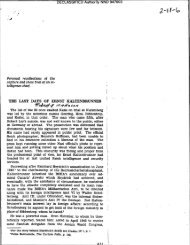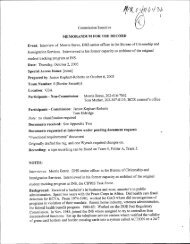Pentagon Papers Part IV - National Archives and Records ...
Pentagon Papers Part IV - National Archives and Records ...
Pentagon Papers Part IV - National Archives and Records ...
Create successful ePaper yourself
Turn your PDF publications into a flip-book with our unique Google optimized e-Paper software.
Declassified per Executive Order 13526, Section 3.3<br />
NND Project Number: NND 63316. By: NWD Date: 2011<br />
<strong>IV</strong>.B Evolution ofthe War (26 Vols.)<br />
Counterinsurgency: The Kennedy Commitments, 1961-<br />
1963 (5 Vols.)<br />
4. Phased Withdrawal of U.S. Forces in Vietnam, 1962-64
Declassified per Executive Order 13526, Section 3.3<br />
NND Project Number: NND 63316. By: NWD Date: 2011
Declassified per Executive Order 13526, Section 3.3<br />
NND Project Number: NND 63316. By: NWD Date: 2011
\.<br />
Declassified per Executive Order 13526, Section 3.3<br />
NND Project Number: NND 633 16. By: NWD Date: 2011<br />
TOP SECRET - Sensitive<br />
SUMMARY<br />
A formal planning <strong>and</strong> budgetary process for the phased withdrawal<br />
of U.S. forces from Vietnam was begun amid the euphoria <strong>and</strong> optimism of'<br />
July 1962, <strong>and</strong> was ended in the pessimism of March 1964 . Initially, t he<br />
specific objectives were : (1) to draw d01Vll U.S. military personnel then<br />
engaged in advisory, training, <strong>and</strong> support efforts from a FY 64 peak of<br />
12,000 to a FY 68 bottoming out of 1,500 (just HQ, MAAG); <strong>and</strong> (2) to reduce<br />
MAP from a FY 64 peak of $180 million to a FY 69 base of $40 .8 million.<br />
South Vietnamese forces were to be trained to perform all the functions then<br />
being carried out by U. S. personnel. What the U.S .G. was a.ctually trying<br />
to accomplish during this period can be described in either or both of<br />
two ways : (1) a r eal desire <strong>and</strong> attempt to extricate the U.S. from direct<br />
military involvement in the war <strong>and</strong> to make it a war which the GVN would<br />
have to l earn to vrin, <strong>and</strong> (2) straight-forward contingency planning <strong>and</strong><br />
the use of a political-managerial t echniq.,ue to SlOV1 down pressures for<br />
greater U. S. inputs. A blend of the vTish embodied in the first explanation<br />
<strong>and</strong> the hard-headedness of the second seems plausible .<br />
Needless to say, the phase-out never came to pass . The Diem coup<br />
with the resulting political instability <strong>and</strong> deterioration of the military<br />
situation soon vTere to lead U. S. decision-makers to set aside this planning<br />
process . An ostensible cut-back of 1000 men did take place in December<br />
1963, but this was essentially an accounting exercise -- cmd the U. S.<br />
force level prior to the reduction had already reached 16,732 in October<br />
1963 · By December 1964, U.S . strength had risen to 23,000 <strong>and</strong> further<br />
deployments were on the ,'lay .<br />
l1hat, then, did the whole phased-withdrawal exercise accomplish?<br />
It may have impeded. dem<strong>and</strong>s for mor e men <strong>and</strong> money, but this is doubtful .<br />
If the optlifiistic reports on the situation in SVN were to be believed,<br />
<strong>and</strong> they apparently were, little more would have been req.,uested . It may<br />
have frightened the GVN, but it did not induce Diem or his successors to<br />
reform the political apparatus or make RVNAF fight harder. It may have<br />
contributed, hOvTever, to public charges about the Administration' s credibility<br />
<strong>and</strong> over-opti.mism about the end of the conflict. Despi te the carefully<br />
worded vJhite House announcement of the phase-out policy on October 2,<br />
1963, tentative Johnson Administration judgments came to be regarded by<br />
the public as' firm predictions. While this announcement made clear that<br />
t'he U. S. effort would continue "until the insu.r.gency has been suppressed<br />
or until the national security forces of the GVN are capable of suppressing<br />
it," the public tended to focus on the prognosis ,vhich follovTed -- "Secretary<br />
McNamara <strong>and</strong> General Taylor r eported their judgment that the major part<br />
of the U. S. military task can be completed by the end of 1965 .... " In<br />
. i TOP SECRET - Sensitive
Declassified per Executive Order 13526, Section 3.3<br />
NND Project Number: NND 63316. By: NWD Date: 2011<br />
TOP SECRET - Sensitive<br />
August 1964, Mr . McNamara further explained the policy: "We have said -as<br />
a matter of fact , I say today -- as our training missions are completed,<br />
vre will bring back the training forces ."<br />
Quite apart from what was actually accomplished by the phase-out<br />
policy <strong>and</strong> the costs in terms of domestic political perceptions of Administration<br />
statements on Vietnam, there are some important lessons to be<br />
learned from this exercise . What was the U.S. rationale behind the policy?<br />
Was it sound, feasible , <strong>and</strong> consistent with statements of national objectives?<br />
By what policy <strong>and</strong> programmatic means were we trying to bring<br />
about the desired results? Were these , in fact , the most appropriate<br />
<strong>and</strong> effective vehicles? How did the intelligence <strong>and</strong> r eporting system<br />
in Vietnam help or hinder policy formulation? Why was not the Diem coup<br />
in its darkening aftermath grasped as the opportunity to r e-examine policy<br />
<strong>and</strong> unamb iguously to decide to phase out, or to do whatever was deemed<br />
necessary? .<br />
The rationale behind the phased withdrawal policy '-las by <strong>and</strong> l arge<br />
internally consistent <strong>and</strong> sensibl e .<br />
To put Vietnam in the perspective of other U. S.<br />
world interests . Vietnam, at this time, \'las not<br />
the focal point of attention in Washington; Berlin<br />
<strong>and</strong> Cuba were . <strong>Part</strong> of this exercise \Vas to make<br />
clear that U.S. interests in Europe <strong>and</strong> i n the<br />
western hemisphere came first . Even i n terms of<br />
Southeast Asia itself, Laos , not Vietnam, was the<br />
central concern. So, the phase-out policy made<br />
the kind of sense that goes along with the structuring<br />
of priorities.<br />
To avoid an open- ended Asian mainl <strong>and</strong> l<strong>and</strong> war .<br />
Even though violated by U.S. i nvolvement in the<br />
Korean war, this was a central tenet of U.S.<br />
national security policy <strong>and</strong> domestic politics .<br />
The notion of the bottomless Asian pit, the<br />
difference in outlook about a human life, were<br />
well under stood .<br />
To plan for the contingency that events might force<br />
withdrawal upon us. Seen i n this light, the planning<br />
process was prudential preparation.<br />
To treat the insurgency as fundamentally a Vietnamese<br />
matter, best solved by the Vietnamese themselves .<br />
Most U.S. deci.sion-makers had well-developed doubts<br />
about the efficacy of us ing "vlh i te faced" soldiers<br />
to fight Asians . This view was invariably coupl ed<br />
publicly <strong>and</strong> privately loTi th statements like this<br />
one made by Secretary McNamara : "I personally<br />
ii- TOP SECRET - Sensitive
Declassified per Executive Order 13526, Section 3.3<br />
NND Project Number: NND 63316. By: NWD Date: 2011<br />
()<br />
:r:<br />
::c<br />
o<br />
Z<br />
o<br />
5<br />
C><br />
-
Declassified per Executive Order 13526, Section 3.3<br />
NND Project Number: NND 63316. By: NWD Date: 2011
<strong>IV</strong>. B. 4.<br />
INTRODUCTION<br />
Declassified per Executive Order 13526, Section 3.3<br />
NND Project Number: NND 63316. By: NWD Date: 2011<br />
TOP SECRET - Sensitive<br />
PHASED WITHDRAWAL OF U.S. FORCES<br />
1962-1964<br />
From mid-1962 to early 1964 the U. S. government went through a formal<br />
planning process, ostensibly designed to disengage the U. S. from direct <strong>and</strong><br />
large-scale military involvement in Vietnam. In retrospect, this experience<br />
falls into place as a more or l ess isolated episode of secondary importance;<br />
eventually abortive, it had little impact on the evolution of the<br />
Vietnam war . It does, however , serve as a vehicle for underst<strong>and</strong>ing one<br />
long phase of the war <strong>and</strong> the U.S. role in it.<br />
The genesis l ay in a conjuncture of circumstances during the first<br />
half of 1962 that prompted the U. S. to shift its Vietnam perspective<br />
from the hitherto restricted one of largely tactical responses to current,<br />
localized, <strong>and</strong> situational requirements, to fitting these to more strategiC<br />
<strong>and</strong> purposeful long-range courses of action. The exp<strong>and</strong>ed perspective<br />
was programmatic in outlook, <strong>and</strong> oriented toward specific goals -- end<br />
the ins1Jxgency <strong>and</strong> withdraw militarily from Vietnam.<br />
At the outset, the motivation for the idea of ph3.sed withdrawal of<br />
U.S. forces was threefold: in part, the belief that developments in Vietnam<br />
itself were going v1ell; in part, doubt over the efficacy of us ing U. S.<br />
forces in an internal war; <strong>and</strong> in part, the dem<strong>and</strong>s of other crises in the<br />
world that were more important to Washington than Vietnam. In the course<br />
of materializing into policy <strong>and</strong> assuming form as plans, these premises were<br />
transformed into conclusions, desiderata institutionalized as objectives,<br />
<strong>and</strong> wish took on the character <strong>and</strong> force of i mperative .<br />
For example, in March 1962, Secretary McNamara testified before Congress<br />
that he was "optimistic" over prospects for U. S. success in aiding<br />
Vietnam, <strong>and</strong> "encouraged 8,t the progress the South Vietnamese are making ."<br />
He expressed conviction that the U. S. would attain its objectives there .<br />
But he emphasized that the U. S. strategy \Vas to avoid participating directly<br />
in the war Ivhile seeking an early military conclusion: y<br />
"I would say definitely we are approaching it from the<br />
point of vie"" of trying to clean it up, <strong>and</strong> t erminating subversion,<br />
covert aggression, <strong>and</strong> combat operations .. . .<br />
" ... We are wise to carryon the operations against the<br />
Communists in that area by assisting native forces rather than<br />
by using U. S. forces for combat .<br />
1 TOP SECRET - Sensitive
Declassified per Executive Order 13526, Section 3.3<br />
NND Project Number: NND 63316. By: NWD Date: 2011<br />
TOP SECRET - Sensitive<br />
The U. S. Military Assistance Advisory Group, Vietnam, had been<br />
augmented in 1961 by aviation) communicatiOns) <strong>and</strong> intellj.gence units)<br />
as well as by Special Forces <strong>and</strong> other advisers. The Secretary of<br />
Defense plainly intended that plans be devised for terminating the<br />
mission of the auwnenting units.<br />
Three days later on 26 July, the JCS formally directed CINCPAC<br />
to develop a Comprehensive Pls.n for South Vietnam (CPSVN) in accordance<br />
with the Secretary's decisions of 23 July. 3/ CINCPAC) in turn, so<br />
instructed COMU SJvrACV on 14 August, at the same time furnishing additional<br />
guidance <strong>and</strong> terms of reference elaborating on the original SecDef<br />
decisions at Honolulu <strong>and</strong> the JCS directive. The stated objective of the<br />
CPSVN was given as:<br />
Develop a capability ivithin mi.lHary <strong>and</strong> para-mHitary<br />
forces of the GVN by the end of CY 65 that wi.ll help the GVN<br />
to achieve the strength necessary to exercise permanent <strong>and</strong><br />
continued sovereignty over that part of Vietnam. vrhich lies<br />
below the demarcation line without the need for continued U.S.<br />
special military assistance.<br />
Development of the plan Has to be based on the following assumptions:<br />
'<br />
a.<br />
b.<br />
c.<br />
The insurgency will be under control at the end of three<br />
years ( end of CY 65).<br />
Extensive U.S. support vri.ll continue to be required during<br />
the three year period, both to bring the insurgency under<br />
control <strong>and</strong> to prepare GVN forces for early take-over of<br />
U.S. activities.<br />
Previous MAP funding ceilings for SVN are not _a 4 P;plicable.<br />
Program those items essential to do this job. /<br />
NATIONAL C.AJ.v1PAIGN PLAN<br />
Planning, in tvo complementary modes) got unden18Y immediately.<br />
Concurrently with development of the unilateral U.S. CPSVN, USMACV<br />
planners prepared a concept <strong>and</strong> proposed outline of a GVN <strong>National</strong> Campaign<br />
Plan ( NCP ) for launching an integrated nation-ivide campaign of<br />
offensive military operations to eliminate the insurgency <strong>and</strong> restore<br />
the country to GVN control. A central purpose was to reorganize <strong>and</strong><br />
redispose the VNAF <strong>and</strong> streamline the chain of comm<strong>and</strong>, in order to<br />
improve responsiveness) coordination, <strong>and</strong> general effectiveness of the<br />
military effort against the VC. Greater authority would be centralized<br />
in the Vietnamese Joint General Staff (JGS)j Corps Tactical Zones ( CTZs )<br />
v(ould be increased from three to four; <strong>and</strong> each CTZ would have its m-ffi<br />
direct air <strong>and</strong> naval support.<br />
5<br />
TOP SECRET - Sensitive
ORGANIZATION<br />
HQ USMACV<br />
HQ MAAG<br />
2D AI R D<strong>IV</strong><br />
USASG (V)<br />
USMC HELICOPTER UNIT<br />
HSAS<br />
TOTAL<br />
12-9-68-2<br />
FIGU RE 2<br />
Declassified per Executi ve Order 13526, Section 3.3<br />
NND Project Number: NND 63316. By: NWD Date: 2011<br />
TOP SECRET - Sensitive<br />
(thous<strong>and</strong>s )<br />
FY63 FY64 FY65 FY66 FY67<br />
.3 .4 .4 .1 .0<br />
3.0 3.0 3.0 1.7 1.6<br />
2.2 2.3 2.3 l.i .0<br />
5.1 5.5 5.5 2.7 .0<br />
.5 .5 .5 .0 .0<br />
.5 .5 .5 .3 .0<br />
11:6 12.2 12.2 5.9 1.6<br />
CPSV N - Forecast of Phase-Out of U.S. Forces (U)<br />
10<br />
FY68<br />
.0<br />
1.5<br />
.0<br />
.0<br />
.0<br />
.0<br />
1.5<br />
TOP SECRET - Sensitive
Declassified per Executive Order 13526, Section 3.3<br />
NND Project Number: NND 63316. By: NWD Date: 2011<br />
TOP SECRET - Sensitive<br />
strength had dropped by 1000 from peak strength, that U.S. military<br />
strength figures in Vietnam be made public, <strong>and</strong> that the actual strength<br />
as well as the authorized ceilings at any given time be carefully monitored<br />
to insure that the desired reductions 1-rere indeed achieved. 29/<br />
A few days later the Secretary of Defense approved the 1000-man withdrawal<br />
plan fOri-larded in JCSM-629-63 as recommended. He agreed, how"ever,<br />
'-lith ISA <strong>and</strong> advised the JCS against creating special units if their only<br />
purpose was to be a holding unit as a vehicle for withdrawal of individuals.<br />
He also requested that he be provided 1-lith a projection of U.S. military<br />
strength in South Vietnam, by month, for the period September through<br />
December 1963. 30/ " .<br />
The following 1-reek the Chairman, JCS, responded to the Secretary of<br />
Defense's request <strong>and</strong> furnished the following projection of end-of-month<br />
U.S. military strengths in South Vietnam:<br />
August 16,201<br />
Sept emb er-- 16,483<br />
October 16,732<br />
November 16,456<br />
December 15,732<br />
It was noted that the planned 1000-man vlithdrawal would represent a reduction<br />
based on the October peak strength. The first increment of 276<br />
personnel vlould be 1-Tithdra1-rn during November arid the remaining increments<br />
in December. 31/ ThiS, as it turned out, i-laS destined to be changed<br />
somel-lhat before the withdrmml was executed.<br />
THE BUDDHIST CRISIS<br />
vlhile the CPSVN-JVlAP <strong>and</strong> "I{ithdrawal planning 1-Tere going on, significant<br />
developments altering the character of the entire situation to which the<br />
planning effort i·ras addressed--in fact threatening to invalidate the very<br />
premises from which the planning sprung--were occurring within South Vietnam.<br />
The Buddhist crisis was rocking the foundations of what precarious political<br />
stability the Diem government enjoyed <strong>and</strong> there "lms grOi-ling concern about<br />
its effect on the prosecution of the war against the VC <strong>and</strong> on improvements<br />
of RVNAF.<br />
A series of incidents beginning early in May revealed the deep divisions<br />
behleen militant Buddhist factions, who purported to speak for the bulk of<br />
the South Vietnamese population, <strong>and</strong> the Government . lack of popular support<br />
for the Diem regime had nOll turned to open opposition. As pass ions flared<br />
16<br />
TOP SECRET - Sensitive
Declassified per Executi ve Order 13526, Section 3.3<br />
NND Project Number: NND 63316. By: NWD Date: 2011<br />
1'OP SECR1"T - Sensitive<br />
"Nml, as Secretary McNamara h8S told you) a serious doubt<br />
hangs over our hopes for the future . Can vre win together in<br />
the face of the reaction to the measures taken by your Government<br />
against the Buddhists <strong>and</strong> the students? As a military man<br />
I would say that VIe can Hin providing there are no further<br />
political setbacks . The military indicators are still generally<br />
favorable <strong>and</strong> can be made more so by actions readily within the<br />
pOiTer of your Government . If you will allmr me ) I would mention<br />
a fe,·r of the military actions -which I believe necessary for this<br />
improvement. II<br />
The Chairman noted that though the military situation in I) II) <strong>and</strong><br />
III Corps· areas V!as generally good, some of the hard-core war zones of<br />
t he Viet Cong remained virtually untouched . There ,rere not enough offensive<br />
actions against the enemy in the field <strong>and</strong>', in his opinion) t he full potential<br />
of the military units Has not being exploited, for 11 •• • only a ruthless)<br />
tireless offensive can \Tin the ..rar . "<br />
The principal military problems) he pointed out) "('Tere noV! in the<br />
Delta, <strong>and</strong> the time had. . come to concentrate efforts there . An overhaul<br />
of the Strategic Hamlet Program WBS needed . For it to succeed)<br />
there must be a related clear-.ynd .. hold campaign by the combat units<br />
of <strong>IV</strong> Corps) <strong>and</strong> the tactics should be oriented to the \Vatenvsys that<br />
were a natural char'scteristic of the region. Furthennore) infantry<br />
line units vTOuld have to operate at full strength, 'l-Tithout divc:r.sion<br />
of combat pOller to rear echelon functions. The CJCS suggested that this<br />
latter problem Has the case in ARVN generally, 'Thich President Diem<br />
might vlant to examine closely.<br />
Finally he summed up vhat \Vas intended as the statement of the US<br />
position:<br />
" In clOSing, Mr . President, may I give you my most import<br />
ant overall impression? Up to now) the battle against the<br />
Viet Cong has seemed endless; no one has been ,Tilling to set<br />
a date for its successful conclusion . After talking to scores<br />
of officers, Vietnamese <strong>and</strong> .American) I am convinced that the<br />
Viet Cong insurgency in the north <strong>and</strong> center can be reduced to<br />
little more than sporadic incidents by the end of 1964. The<br />
Delta ,vill take longer but should be completed by the end of<br />
1965. But for these predictions to be valid, certain conditions<br />
must be met . Your Government shoul d be prepared to energize all<br />
agencies, military <strong>and</strong> civil, to a higher output of activity than<br />
up to nov . Ineffective c ormn<strong>and</strong>ers <strong>and</strong> province officials must<br />
be replaced as soon as identified . Finally) there should be a<br />
r estoration of domestic tranquility on the homefront if political<br />
t ensions are to be allayed <strong>and</strong> external criticism is to abate .<br />
Conditions are need.ed for the creation of an atmosphere conducive<br />
t o an effective campaign directed at the objective, vital to both<br />
20 TOP SECRET ., Sensitive
Declassified per Executive Order 13526, Section 3.3<br />
NND Project Number: NND 63316. By: NWD Date: 2011<br />
TOP SECRET - Sensitive<br />
THE 1000-MAN WITHDRAI"AL OF DECEMBER 1963<br />
During the month of December, the planned 1000-man reduction was<br />
executed. It proved essentially an accounting exercise . Technically,<br />
more than a thous<strong>and</strong> U.S. personnel did leave, but many of these were part<br />
of the normal turnover cycle, inasmuch as rotation policy alone, not to<br />
mention medical evacuation or administrative reasons, resulted in an<br />
average rate of well over a thous<strong>and</strong> returnees per month. Though the<br />
replacement pipeline IoTas slOl·red somevrhat, year-end total in-country strength<br />
nevertheless vTaS close to 16,000. 52/ This did not even represent a<br />
decline of 1000 from the October peak of 16,732.<br />
1'hat the avm-red goal of 1000 would not be reached had in fact been<br />
anticipated <strong>and</strong> acknmrledged before mid-December . Despite close monitoring<br />
of authorized ceilings <strong>and</strong> actual strengths, the force level kept rising.<br />
On 11 December, for example, the estimate of projected year-end U.S.<br />
strength in Vietnam had to be revised upward to reflect additional deployments<br />
approved since September. The adjusted figure now came to 15,894,<br />
a net increase of 162 over the. earlier estimate . This new strength ceiling<br />
was 'ioJ'hat would be left after the 1000-man vrithdravral then in progress vras<br />
completed. 53/<br />
THE VIETNAM SITUATION WORSENS<br />
In December conflicting estimates of the situation in Vietnam indicated<br />
that the bright hopes <strong>and</strong> predictions of the past vrere increasingly<br />
less than realistic. A McNamara memo to the President ,vritten follOl'Ting<br />
a trip to Vietnam of 21 December, was laden \oJ'ith gloom. 54/ He wrote:<br />
liThe situation is very disturbing. Current trends, unless reversed in<br />
t he next 2-3 months, I·rill lead to neutralization at best <strong>and</strong> more likely<br />
. to a cormnunist-controlled state . 11 He went on to note that lithe ne'ioJ' government<br />
is the greatest source of concern, " <strong>and</strong> that "it is indecisive <strong>and</strong><br />
drifting." The Country Team, he added, "lacks leadership, <strong>and</strong> has been<br />
poorly informed." One of the most serious deficiencies he found .TaS a<br />
IIgrave reporting ,.,eakness" on the U.S. side . "Viet Cong progress has been<br />
great during the period since the coup, with my best guess being that the<br />
situation has in fact been deteriorating i n the countryside since July to<br />
a far greater extent than "e realize because of our undue dependence on<br />
distorted Vietnamese reporting." Mr . McNamara clearly concluded that none<br />
of these conditions could be reversed by the influx of more American<br />
personnel, nor did he even mention that the U.S. could continue to withdraw<br />
troops at all or as scheduled . His proposal Has to hold the l ine : "u. S.<br />
resources <strong>and</strong> personnel," he said, "cannot usefully be substantially<br />
i ncreased . • . 7 " although he did announce his intention to increase staffs<br />
lito sizes that will give us a reliable, independent U.S. appraisal of the<br />
status of operations." In h:i,s concluding paragraph, hOl.rever, the Secretary<br />
of Defense admitted that his OHn estimate IImay be overly pessimistic," inasmuch<br />
as the Ambassador, COYIUSMACV, <strong>and</strong> General Minh ,.,ere not discouraged<br />
<strong>and</strong> looked fonrard to significant jJnprovements in January . ',24/<br />
TOP SECRET - Sensitive
'{ I'<br />
Declassified per Executi ve Order 13526, Section 3.3<br />
NND Project Number: NND 63316. By: NWD Date: 2011<br />
TOP SECRET - Sensitive<br />
have completed the majority of the training task by that time.<br />
This, in General Taylor's vie"T <strong>and</strong> mine, is what ,{e should be<br />
able to do. If we do, 'rle should bring our men back.<br />
"I don ' t believe we should leave our men there to substitute<br />
for Vietnamese men ,{ho are qualified to carry out the task, <strong>and</strong><br />
this is really the heart of our proposal. I think it I-laS a sound<br />
proposal then <strong>and</strong> I think so noVT •• •• "<br />
Unsureness about the actual state of affaiNs in Washington spread<br />
eventually to the highest levels of government, <strong>and</strong> prompted the dispatching<br />
to South Vietnam in early February of a CIA "Special CAS Group"<br />
for an independent evaluation of the military situation. A series of<br />
four reports, dated 10, 11, 14 <strong>and</strong> 18 February 19611-, were produced, each<br />
transmitted by the Deputy Director, CIA, to the Secretary of Defense,<br />
Secretary of State, <strong>and</strong> others as soon as it came out. Instead of finding<br />
progress, these reported a serious <strong>and</strong> steadily deteriorating situation.<br />
Cited vere VC gains in the past several months, <strong>and</strong> particularly noted VTas<br />
that VC arms were increasing in quantity <strong>and</strong> quality. As for the Strategic<br />
Hamlet Program, they found it "at present at virtual st<strong>and</strong>still. " The<br />
Special CAS Group ' s concluding appraisal vas pessimistic: "Tide of<br />
insurgency in all four corps areas appears to be going against GVN." 58/<br />
COMUSMACV (who had no prior knovledge of the Special CAS Group ' s reports )<br />
took issue vlith the Group's findings} contesting less the data used than<br />
the conclusions, especially the "personal" evaluational opinions as to<br />
degree of deterioration. He suggested that in the future such reports<br />
be first coordinated before being dispatched. 59/<br />
On 6 March a major Secretary of Defense Conference again convened at<br />
CINCPAC headquarters for a broad reassessment. The consensus was that the<br />
military situation was definitely deteriorating. No longer was the issue<br />
'rlhether it vas progressing satisfactorily or not. The question now ioTaS<br />
how much of a setback had there been <strong>and</strong> what was needed to make up for it.<br />
An opinion shared by many ,{as that the insurgency could be expected to go<br />
beyond 1965. This general reorientation of perspective was reflected in<br />
the Secretary of Defense ' s observation that attention should be focused on<br />
the near-term objectives of providing the greater U.S. support that would<br />
be necessary, <strong>and</strong> suspending for the time being consideration of longerrange<br />
concerns such as 5-year MAP projections. 60/ The visit to Vietnam<br />
on 8 March corroborated the gravity of the im:mediate problems at h<strong>and</strong>.<br />
FollOl.,ring his return from Vietnam, Mr. McNamara, on 16 March, sub<br />
mitted to the President a formal report. In it the Secretary of Defense<br />
acknowledged, "The situation has unquestionably been grmling 'rlOrse, at<br />
l east since September." RVNAF desertion rates were i ncreas.ing, <strong>and</strong> the GVN<br />
military position generally 'rTaS "Teakening noticeably. The VC position, on<br />
the other h<strong>and</strong>, shoved signs of improving. He referred pointedly to the<br />
increase in North Vietnamese support. The conclusion was that greater<br />
U 0 So support ,vas needed.<br />
TOP SECRET - Sensitive
Declassified per Executi ve Order 13526, Section 3.3<br />
NND Project Number: NND 63316. By: NWD Date: 2011<br />
TOP SECRET - Sensitive<br />
In describing vThat I-TaS required to improve the situation in South<br />
Vietnam) Mr. McNamara identified measures that uwill involve? limited<br />
increase in U,S. personnel <strong>and</strong> in direct Defense Department costs. More<br />
significantly they involve significant increases in Military Assistance<br />
Program costS ... , )fI plus fladditional U.S. economic aid to support the<br />
increased GVN budget. II The estimated additional annual MAP costs 'dould<br />
come to between $30 <strong>and</strong> $40 million each year) plus a one-time additional<br />
cost of $20 million for military equipment. In the recommendation section<br />
of the report) the Secretary listed the following 12 items:<br />
1. To make it clear that \ire are prepared to furnish assistance<br />
<strong>and</strong> support to South Vietnam for as long as it takes to bring<br />
the insurgency under control.<br />
2. To make it clear that we fully support the Khanh government<br />
<strong>and</strong> are opposed to any further coups.<br />
3. To support a Program for <strong>National</strong> Mobilization ( including a<br />
national service law) to put South Vietnam on a war footing.<br />
4 . To assist the Vietnamese to increase the armed forces (regular<br />
plus paramilitary) by at least 50)000 men.<br />
5 · To assist the Vietnamese to create a greatly enlarged Civil<br />
Administrative Corps for vTOrk at province) district <strong>and</strong> hamlet<br />
levels.<br />
6. To assist the Vietnamese to improve <strong>and</strong> reorganize the paramilitary<br />
forces <strong>and</strong> to increase their compensation.<br />
7. To assist the Vietnamese to create an offensive guerrilla force.<br />
8 . To provide the Vietnamese Air Force 25 A-IH aircraft in exchange<br />
f or the present T-28s.<br />
9. To provide the Vietnamese army additional M-113 armored personnel<br />
carriers (w'ithdrawing the M-114s there), additional river boats)<br />
<strong>and</strong> approximately $5-10 million of other additional material.<br />
10. To announce publicly the Fertilizer Program <strong>and</strong> to exp<strong>and</strong> it<br />
with a vieH l{ithin tyro years to trebling the amount of fertilizer<br />
made ayailable .<br />
11. To authorize continued high-level U. S. overflights of South<br />
Vietnam' s borders <strong>and</strong> to authorize !thot pursuit U <strong>and</strong> South Vietnamese<br />
ground operations over the Laotian line for the purpose<br />
of border· control. More ambitious operations into Laos involving<br />
units beyond battalion size should be authorized only with the<br />
approval of Souvanna Phouma. Operations across the Cambodian<br />
border should depend on the state of relations with Cambodia .<br />
TOP SECRET - Sensitive
Declassified per Executive Order 13526, Section 3.3<br />
NND Project Number: NND 63316. By: NWD Date: 2011<br />
TOP SECRET - Sensitive<br />
deployment package. The following day, at the NSC meeting of 21 July,<br />
the President gave it final approval, though that action was not included<br />
in the NSAM issued the next day. 67/<br />
As eventually refined, the total force increment actually came to<br />
over 4900 u.s. personnel. In addition, other requirements not directly<br />
related to the advisory effort itself were being generated <strong>and</strong> met independently.<br />
By the close of 1964 the year-end U.S. in-country strength<br />
figure had climbed to approximately 23,000 personnel <strong>and</strong> further authorized<br />
deployments were under way or in preparation.<br />
The actual effect of "phased withdrawals" was minimal. Though 1,000<br />
spaces among the personnel authorized MACV vTere eliminated in 1963, add-ons<br />
overtook cut-backs. As an example, U.S. Army strength in Vietnam--the bulk<br />
of the advisory effort--vras allocated as follows:<br />
PERCENTAGE OF U.S. ARMY STRENGTH IN VIETNAM fBI<br />
Total Army Hq & Spt Aviation Communica- Special Other<br />
Strength Units Units tion Units Forces Advisers<br />
Nov 63 10,000 17 35 15 6 27<br />
Mar 64 10,000 19 34 13 7 27<br />
Nov 6'+ 14,000 28 30 12 8 22<br />
POSTSCRIPT TO HITHDRAHAL PLANNING<br />
The official termination of formal planning tmrards withdravlal by<br />
no means ended its attraction as one issue in the grmTing public debate<br />
over Vietnam policy. In August, 1964, the Tonkin Gulf crisis brought<br />
Congressmen back in perplexity to Secretary McNamara's statements on withdra;.rals,<br />
<strong>and</strong> elicited the following exchange:<br />
" . .. LSecretary McNamara, you7 have again always indicated that<br />
you hoped that by the end of this year there ;.rould have been a substantial<br />
reduction .... \{here we had a planned reduction of the<br />
number of troops, <strong>and</strong> what appeared to be a ;.rithdrawal of the United<br />
States from the area, then this attack comes, "lvhich would put us<br />
finnly in the area, or at least change our mind. The ;.rhole thing,<br />
to me, is completely, at least, not underst<strong>and</strong>ing.<br />
SECRETARY McNAVLARA: "The · period, December 1961, through the<br />
summe r of 1963 was a period of great progress within South Vietnam,<br />
in countering the effort of the Viet Cong to overthro;.r that government.<br />
However, starting in May, 1963, you ;.rill r ecall, a series<br />
of religious riots developed, controversy 'within the country developed,<br />
lead.ing eventually upon Novembe r 2nd to the overthro;.r of the<br />
Diem government . Prior to that time in September, 1963, General<br />
39<br />
TOP SECRET - Sensitive
Declassified per Executive Order 13526, Section 3.3<br />
NND Project Number: NND 63316. By: NWD Date: 2011<br />
TOP SECREl' - Sensitive<br />
Taylor <strong>and</strong> I had advised <strong>and</strong> visited that country. At that time)<br />
the progress of the counter insurgency effort was so great it<br />
appeared that ,ve "lould be able to withdrav much of our training<br />
force by the end of 1965, <strong>and</strong> not 1964, <strong>and</strong> .le would -- we so stated<br />
upon our return. But follOlving that -- <strong>and</strong> I should also mention<br />
that in that same statement, vre made in September, 1963, vre pointed<br />
out the very serious nature of the political difficulties that were<br />
building up i n South Vietnam, because of the conf lict between the<br />
Buddhists <strong>and</strong> the CatholiCS, <strong>and</strong> the government.<br />
"In any event, as I say, in November, 1963, the government was<br />
overthrmrn. There vTaS another change of government January 30th,<br />
<strong>and</strong> this completely changed the outlook <strong>and</strong> the political instability<br />
that followed the tvro coups has given the Viet Cong an opportunity<br />
to take advantage of the political <strong>and</strong> military weakness. They have<br />
taken advantage of H. It is now necessary to add further U. S. military<br />
assistance to counter that Viet Cong offensive ....<br />
"We have never made the statement since September, 1963, that ive<br />
believed .le could bring the bulk of the training forces out by the<br />
end of 1965, because the actions in November <strong>and</strong> January made it<br />
quite clear that would not be possible.<br />
"We have said -- as a matter of fact, I say today - - as our<br />
training missions are cOIllpleted, we will bring back the training<br />
forces . I think this is only good sense, <strong>and</strong> good judgment. We<br />
have c ertain trainj.ng missions that I hope .le can complete this<br />
year, <strong>and</strong> others next year, <strong>and</strong> the forces associated vrith those<br />
miss ions should be brought back.<br />
"We have forces there training the Vietnamese to fly spotter<br />
aircraft, for artillery spotting purposes. I am very hopeful<br />
that we can bring the U.S. forces out as the Vietnamese acquire<br />
that capability.<br />
"On the other h<strong>and</strong>, the Vietnamese quite clearly need additional<br />
assistance in training for counter guerrilla operations,<br />
because of the increased guerrilla activities of the Viet Cong,<br />
<strong>and</strong> we are sending additional special forces to Vietnam for that<br />
purpose .<br />
"There :vill be a flml in both directions, but I am certain in<br />
the next several months the net flow will be strongly tOlvard South<br />
Vietnam . " 69/<br />
After Tonkin Gulf, the policy objective of gradual disengagement<br />
from Vietnam was no longer relevant. The hope, as .lell as the concept<br />
of phase out <strong>and</strong> .rithdrawal, dwindled, since such ivithdrawal was now seen<br />
as tantamount to surrendering SVN to Hanoi . The issue for the future<br />
would no longer be wi thdraiVal s, but what additional U. S. forces i{QuId be<br />
required to stem the tide--<strong>and</strong> hOiv fast they would have to be thrown into<br />
action.<br />
40 TOP SECRET - Sensitive
Declassified per Executive Order 13526, Section 3.3<br />
NND Project Number: NND 63316. By: NWD Date: 2011




